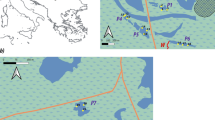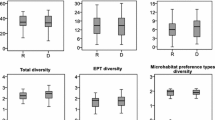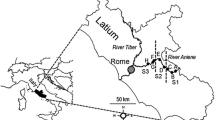Abstract
This study addressed the influence of common shoreline engineering structures (off-bankline revetment, rip rap and wing dike) on richness, biomass and secondary production of native and non-native macroinvertebrates in the navigation channel and near-shore habitats in the Elbe River (Germany). Within the navigation channel, only marginal differences among engineering structures were observed, and non-native species were absent from all samples. At the shoreline, secondary production of non-native species was significantly greater at the rip rap and represented 59% of total secondary production in near-shore habitats. Conversely, secondary production of native species at the shoreline was 9-fold lower at the rip rap and more than twice the rates at the wing dike. Differences in secondary production among engineering structures were attributed to differential distribution of substrate types. Boulder substrates, the dominant substrate type in the rip rap, promoted contributions of non-native species while macrophytes and silt were associated with high contributions of native species at the off-bankline revetment. Our results reveal that the morphological configuration of engineering structures in large rivers not only controls the rate of secondary production for macroinvertebrates but also the contribution of non-native species to total community functioning.





Similar content being viewed by others
References
Aberle, J., V. Nikora, M. Henning, B. Ettmer & B. Hentschel, 2010. Statistical characterization of bed roughness due to bed forms: a field study in the Elbe River at Aken, Germany. Water Resources Research 46: 1–11.
Angradi, T. R., E. W. Schweiger & D. W. Bolgrien, 2006. Inter-habitat variation in the benthos of the Upper Missouri River (North Dakota, USA): implications for great river bioassessment. River Research and Applications 22: 755–773.
Armitage, P. D., K. Lattmann, N. Kneebone & I. Harris, 2001. Bank profile and structure as determinants of macroinvertebrate assemblages—seasonal changes and management. Regulated Rivers: Research and Management 17: 543–556.
Arthington, A. H., S. E. Bunn, N. L. Poff & R. J. Naiman, 2006. The challenge of providing environmental flow rules to sustain river ecosystems. Ecological Applications 16: 1311–1318.
Babler, A. L., C. T. Solomon & P. R. Schilke, 2008. Depth-specific patterns of benthic secondary production in an oligotrophic lake. Journal of the North American Benthological Society 27: 108–119.
Baumgärtner, D. & K.-O. Rothhaupt, 2003. Predictive length–dry mass regressions for freshwater invertebrates in a pre-alpine lake littoral. International Review of Hydrobiology 88: 453–463.
Beauger, A., N. Lair, P. Reyes-Marchant & J.-L. Peiry, 2006. The distribution of macroinvertebrate assemblages in a reach of the River Allier (France), in relation to riverbed characteristics. Hydrobiologia 571: 63–76.
Benke, A. C., 1979. Modification of the Hynes method for estimating secondary production with particular significance for multivoltine populations. Limnology and Oceanography 24: 168–171.
Benke, A. C. & A. D. Huryn, 2007. Secondary production of macroinvertebrates. In Hauer, F. R. & G. A. Lamberti (eds), Methods in Stream Ecology. Academic, New York: 691–710.
Benke, A. C., T. C. Van Arsdall, D. M. Gillespie & F. K. Parrish, 1984. Invertebrate productivity in a subtropical blackwater river: the importance of habitat and life history. Ecological Monographs 54: 25–63.
Benke, A. C., A. D. Huryn, L. A. Smock & J. B. Wallace, 1999. Length–mass relationships for freshwater macroinvertebrates in North America with particular reference to the southeastern United States. Journal of the North American Benthological Society 18: 308–343.
Bij de Vaate, A., K. Jazdzewski, H. A. M. Ketelaars, S. Gollasch & G. van der Velde, 2002. Geographical patterns in range extension of Ponto-Caspian macroinvertebrate species in Europe. Canadian Journal of Fisheries and Aquatic Sciences 59: 1159–1174.
Burgherr, P. & E. I. Meyer, 1997. Regression analysis of linear body dimensions vs. dry mass in stream macroinvertebrates. Archiv für Hydrobiologie 139: 101–112.
Cogerino, L., B. Cellot & M. Bournaud, 1995. Microhabitat diversity and associated macroinvertebrates in aquatic banks of a large European river. Hydrobiologia 304: 103–115.
Cross, W., E. Rosi-Marshall, K. Behn, T. Kennedy, R. Hall Jr., A. E. Fuller & C. Baxter, 2010. Invasion and production of New Zealand mud snails in the Colorado River, Glen Canyon. Biological Invasions 12: 3033–3043.
Cross, W. F., C. V. Baxter, K. C. Donner, E. J. Rosi-Marshall, T. A. Kennedy, R. O. Hall, H. A. W. Kelly & R. S. Rogers, 2011. Ecosystem ecology meets adaptive management: food web response to a controlled flood on the Colorado River, Glen Canyon. Ecological Applications 21: 2016–2033.
Dick, J. T. A., D. Platvoet & D. W. Kelly, 2002. Predatory impact of the freshwater invader Dikerogammarus villosus (Crustacea: Amphipoda). Canadian Journal of Fisheries and Aquatic Sciences 59: 1078–1084.
Didham, R. K., J. M. Tylianakis, N. J. Gemmell, T. A. Rand & R. M. Ewers, 2007. Interactive effects of habitat modification and species invasion on native species decline. Trends in Ecology and Evolution 22: 489–496.
Dixon, K. M., 1986. Secondary production of macroinvertebrates from selected habitats of the unchannelized Missouri River. PhD Thesis, University of South Dakota.
Elosegi, A. & S. Sabater, 2013. Effects of hydromorphological impacts on river ecosystem functioning: a review and suggestions for assessing ecological impacts. Hydrobiologia 712: 129–143.
Garcia, X.-F., I. Schnauder & M. T. Pusch, 2012. Complex hydromorphology of meanders can support benthic invertebrate diversity in rivers. Hydrobiologia 685: 49–68.
Gregory, K. J., 2006. The human role in changing river channels. Geomorphology 79: 172–191.
Hall, R. O., M. F. Dybdahl & M. C. VanderLoop, 2006. Extremely high secondary production of introduced snails in rivers. Ecological Applications 16: 1121–1131.
Hamilton, A. L., 1969. On estimating annual production. Limnology and Oceanography 14: 771–782.
Hardenbicker, P., S. Rolinski, M. Weitere & H. Fischer, 2014. Contrasting long-term trends and shifts in phytoplankton dynamics in two large rivers. International Review of Hydrobiology 99: 287–299.
Henning, M. & B. Hentschel, 2013. Sedimentation and flow patterns induced by regular and modified groynes on the River Elbe, Germany. Ecohydrology 6: 598–610.
Hulme, P. E., S. Bacher, M. Kenis, S. Klotz, I. Kühn, D. Minchin, W. Nentwig, S. Olenin, V. Panov, J. Pergl, P. Pyšek, A. Roques, D. Sol, W. Solarz & M. Vilà, 2008. Grasping at the routes of biological invasions: a framework for integrating pathways into policy. Journal of Applied Ecology 45: 403–414.
Huryn, A. D., 1996. An appraisal of the Allen paradox in a New Zealand trout stream. Limnology and Oceanography 41: 243–252.
Hynes, H. B. N. & M. J. Coleman, 1968. A simple method of assessing the annual production of stream benthos. Limnology and Oceanography 13: 569–573.
Johnston, T. A. & R. A. Cunjak, 1999. Dry mass–length relationships for benthic insects: a review with new data from Catamaran Brook, New Brunswick, Canada. Freshwater Biology 41: 653–674.
Junk, W. J., P. B. Bayley & R. E. Sparks, 1989. The flood pulse concept in river–floodplain systems. In Dodge, D. P. (ed), Proceedings of the International Large River Symposium. Canadian Special Publication of Fisheries and Aquatic Sciences, Ottawa: 110–127.
Kleinwächter, M., T. O. Eggers, M. Henning, A. Anlauf, B. Hentschel & O. Larink, 2005. Distribution patterns of terrestrial and aquatic invertebrates influenced by different groyne forms along the River Elbe (Germany). Large Rivers 15: 319–338.
Leuven, R. S. E. W., G. van der Velde, I. Baijens, J. Snijders, C. van der Zwart, H. J. R. Lenders & A. bij de Vaate, 2009. The River Rhine: a global highway for dispersal of aquatic invasive species. Biological Invasions 11: 1989–2008.
MacDougall, A. S. & R. Turkington, 2005. Are invasive species the drivers or passenger of change in degraded ecosystems? Ecology 86: 42–55.
MacNeil, M. A., D. Platvoet, J. T. A. Dick, N. Fielding, A. Constable, N. Hall, D. Aldrige, T. Renals & M. Daimond, 2010. The Ponto-Caspian “killer shrimp”, Dikerogammarus villosus (Sowinsky, 1894), invades the British Isles. Aquatic Invasions 5: 441–445.
McCartney, B., T. Pokrefke, M. Cox, D. Gordon, S. Ellis, W. H. McAnally & F. Pinkard, 2012. Inland Navigation Channel Training Works. American Society of Civil Engineers, Reston.
Meyer, E., 1989. The relationship between body length parameters and dry mass in running water invertebrates. Archiv für Hydrobiologie 117: 191–203.
Pehofer, H. E., 1998. A new quantitative air-lift sampler for collecting invertebrates designed for operation in deep, fast-flowing gravel bed rivers. Large Rivers 11: 213–232.
Peipoch, M., M. Brauns, F. R. Hauer, M. Weitere & H. M. Valett, 2015. Ecological simplification: human influences on riverscape complexity. Bioscience. doi:10.1093/biosci/biv120.
Poepperl, R., 1998. Biomass determination of aquatic invertebrates in the Northern German lowland using the relationship between body length and dry mass. Faunistisch-Ökologische Mitteilungen 7: 379–386.
R Core Team, 2013. R: A Language and Environment for Statistical Computing. R Foundation for Statistical Computing, Vienna [available on internet at http://www.r-project.org/].
Reid, D. & M. Church, 2015. Geomorphic and ecological consequences of riprap placement in river systems. Journal of the American Water Resources Association. doi:10.1111/jawr.12279.
Scholten, M., A. Anlauf, B. Büchele, P. Faulhaber, K. Henle, S. Kofalk, I. Leyer, J. Meyerhoff, J. Purps, G. Rast & M. Scholz, 2005. The River Elbe in Germany: present state, conflicting goals, and perspectives of rehabilitation. Large Rivers 15: 579–602.
Shea, K. & P. Chesson, 2002. Community ecology theory as a framework for biological invasions. Trends in Ecology and Evolution 17: 170–176.
Spiess, A. N., 2014. Propagate: propagation of uncertainty [available on internet at http://cran.r-project.org/package=propagate].
Strayer, D. L., 2012. Eight questions about invasions and ecosystem functioning. Ecology Letters 15: 1199–1210.
Strayer, D. L. & S. E. G. Findlay, 2010. Ecology of freshwater shore zones. Aquatic Sciences 72: 127–163.
Strayer, D. L., S. E. G. Findlay, D. Miller, H. M. Malcom, D. T. Fischer & T. Coote, 2012. Biodiversity in Hudson River shore zones: influence of shoreline type and physical structure. Aquatic Sciences 74: 597–610.
Strayer, D. L., J. J. Cole, S. E. G. Findlay, D. T. Fischer, J. A. Gephart, H. M. Malcom, M. L. Pace & E. J. Rosi-Marshall, 2014. Decadal-scale change in a large-river ecosystem. Bioscience 64: 496–510.
Sukhodolov, A., W. S. J. Uijttewaal & C. Engelhardt, 2002. On the correspondence between morphological and hydrodynamical patterns of groyne fields. Earth Surface Processes and Landforms 27: 289–305.
Surian, N. & M. Rinaldi, 2003. Morphological response to river engineering and management in alluvial channels in Italy. Geomorphology 50: 307–326.
Szlauer-Łukaszewska, A., 2015. Effects of river bed regulation on habitats and communities: a case study for ostracods in the Oder River, Poland. International Review of Hydrobiology 100: 69–78.
Vanderploeg, H. A., T. F. Nalepa, D. J. Jude, E. L. Mills, K. T. Holeck, J. R. Liebig, I. A. Grigorovich & H. Ojaveer, 2002. Dispersal and emerging ecological impacts of Ponto-Caspian species in the Laurentian Great Lakes. Canadian Journal of Fisheries and Aquatic Sciences 59: 1209–1228.
Waringer, J. A. & U. H. Humpesch, 1984. Embryonic development, larval growth and life cycle of Coenagrion puella (Odonata: Zygoptera) from an Austrian pond. Freshwater Biology 14: 385–399.
Acknowledgments
We thank Sven Bauth, Stefanie Brabender, Martin Diener, Andrew Kaus, Claudia Hellmann, Kamilla Kubaczynski, Michael Schäffer and Jennifer Wey for their assistance with the field work. We thank Emmanuel Gaulme and Xavier-Francois Garcia for the determination and the length measurement of Chironomidae. We are grateful to Olaf Büttner who helped with the calculation of the wetted area of the mesohabitats. Daniel von Schiller, Marc Peipoch and H. Maurice Valett provided helpful comments that improved earlier versions of the manuscript.
Author information
Authors and Affiliations
Corresponding author
Additional information
Handling editor: Katya E. Kovalenko
Electronic supplementary material
Below is the link to the electronic supplementary material.
Rights and permissions
About this article
Cite this article
Brabender, M., Weitere, M., Anlanger, C. et al. Secondary production and richness of native and non-native macroinvertebrates are driven by human-altered shoreline morphology in a large river. Hydrobiologia 776, 51–65 (2016). https://doi.org/10.1007/s10750-016-2734-6
Received:
Revised:
Accepted:
Published:
Issue Date:
DOI: https://doi.org/10.1007/s10750-016-2734-6




